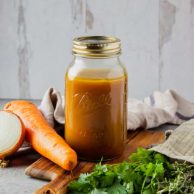
Our friend Mitten Lowe at Journey to Wellness is a fan of bone broth (with actual bones, as well as one that’s vegan) whenever the season changes. What’s more gratifying than taking fresh vegetables and herbs you’ve grown, or bought by supporting our local farmers, and simmering them for a fragrant, nutrient-dense health and spirit builder when the temperatures plummet?
photo courtesy: Garden in the Kitchen
Mitten, a wellness coach and herbalist, says: “A couple of really important notes about bone broth. It’s delicious and one of the most nourishing foods you can consume. Bone broth is a straight shot (literally) of minerals (calcium, magnesium, phosphorus and trace minerals) and contains collagen which aids in mineralization of teeth and bones. Bone broth is also essential for healing the mucosal lining of the gut. I always say, if you are not already using bone broth regularly for your general health, you should be! Try the recipe below and enjoy incredible nourishment year round.”
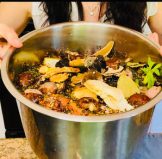 How To Make Bone Broth:
How To Make Bone Broth:
Broth can be cooked on the stovetop on low heat, or in a slow cooker (crock pot), and also in an instant pot! I save all of my meat bones and veggie scraps in a bag in the freezer. These are added to my broth.
Ingredients:
2-3 pounds of bones (Include 2-4 chicken feet if you have them), if using fish, use non-oily only. If using beef bones, you may want to roast them first for added flavor.)
4 quarts of cold filtered water
2 Tbsp to ½ cup apple cider vinegar
1 bunch parsley
2 bay leaves
Optionally add 1 -3 onions, 2-3 carrots, 2-3 celery stalks, Most veggies are fine with the exception of cruciferous vegetables like cauliflower, broccoli, kohlrabi and kale.
Optionally add spices as desired,
Optionally add 1-3 garlic cloves and 1-3 TB ginger
Directions:
-Put bones, meat, vinegar, water, any spices and all vegetables (except parsley) in stainless steel pot, crock pot or instant pot. Let stand for 30 minutes to 1 hour. In an instant pot, there is no need to let stand.
-If using an instant pot, set to 180 minutes on high and you’re done until straining! If using a stainless steel pot, bring to boil.
-Skim the scum off of the surface of the water.
-Reduce heat, cover and simmer. For fish, at least 2 hours; for poultry, at least 8 hours; for beef, at least 12 hours.
-Add the parsley in the last 10 minutes for crock pot or stove top..
-Strain, let cool, and refrigerate. Observe amount of gelatin in broth, and make adjustments to cooking time, and vinegar amount, accordingly.
-Optionally remove congealed fat that rises to the top. I leave mine on.
-Freeze any broth that you won’t be using within 7 days.
HERE is an instructional video for making bone stock in the Instant Pot
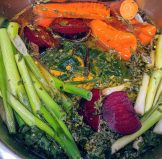
Vegan Broth
Vegan ‘Bone Broth’ has real nutritional power, too. A recipe we make every winter, this broth provides minerals and more from common stinging nettle, Urtica dioica. Nettle has been used for centuries for joint health, eczema, arthritis, gout, anemia and seasonal allergy symptoms. Stinging nettle is high in amino acids, protein, flavonoids, and bone-building minerals like iron, calcium, magnesium, potassium, silica and zinc. Nettle contains vitamins and minerals that can help keep your bones strong (Gupta, 2021), and it is one of the greatest sources of vitamin K.
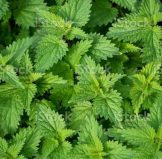
Stinging Nettles, Urtica dioica
Nettle is an all-too easy perennial to grow. In the right place, nettle spreads to form large patches — just what you’re looking for if you’re drying and preserving this herb for use in broth and tea, or for fibers to make cloth. Plant any time after frost, water in for the first year, and let it go. Nettle can take full sun or partial shade and, though native to moist areas, can take drought (although it appreciates some moisture during the hottest parts of the season). Be sure to harvest leaves in mid-to-late spring, before the abundant seeds appear.
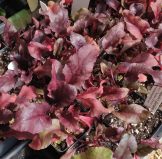
Beet, Beta vulgaris
The beet, Beta vulgaris, is full of folate (vitamin B9), manganese, potassium, iron and vitamin C, and has been used medicinally since ancient times for blood flow, to lower blood pressure, and for increased exercise performance. You can plant beet seeds and transplants two weeks before the average last frost date, and even earlier with protection like a low tunnel.
Try this winter healing broth!
Ingredients:
- 8-12 cups water (must cover your veggies with some room!)
- 1 tbsp coconut oil
- 1 tbsp extra virgin olive oil
- 1 onion onion quartered (with skins)
- 1 bunch green onion chopped
- 2 garlic bulbs smashed
- 1 yellow or orange pepper roughly chopped (with seeds)
- 2 inch piece of ginger roughly chopped (with skin)
- 4 cups beet greens (can substitute other greens)
- 4 large or 6-8 medium beets quartered (with skins)
- 3-4 cups mixed chopped vegetables and peelings (I used carrot peelings, red cabbage, fresh mushrooms, leeks and celery)
- 2 small potatoes quartered (with skins)
- 2 small or one medium sweet potato quartered
- 1 tbsp peppercorns
- 1 tbsp dried oregano
- 2 tbsp ground turmeric
- 1 tbsp coconut aminos
- 1 whole nutmeg
- 1 tbsp whole coriander seeds
- 2 bay leaves
- 1/8 – 1/4 cup nutritional yeast flakes for extra flavor and vitamins
- 1/4 cup dried nettle or 1 cup fresh nettle
- Himalayan pink or sea salt to taste
Instructions:
- Simply add everything to a large pot or Instant Pot. If you are preparing this broth on the stove top, bring to a boil. Simmer covered for 2-3 hours. In the Instant Pot, use the manual setting for 80 minutes.
- Once everything has been cooked down, strain the liquid into a large bowl using a fine mesh strainer.
- Serve immediately with Himalayan pink or sea salt, or cool for later. You can also freeze in mason jars for future use. Be sure to cool completely in the fridge before freezing.
Recipe courtesy Mitten Lowe at Journey to Wellness.
